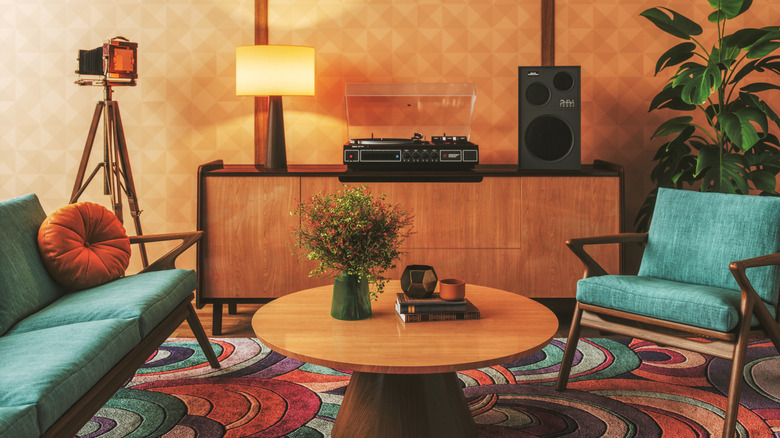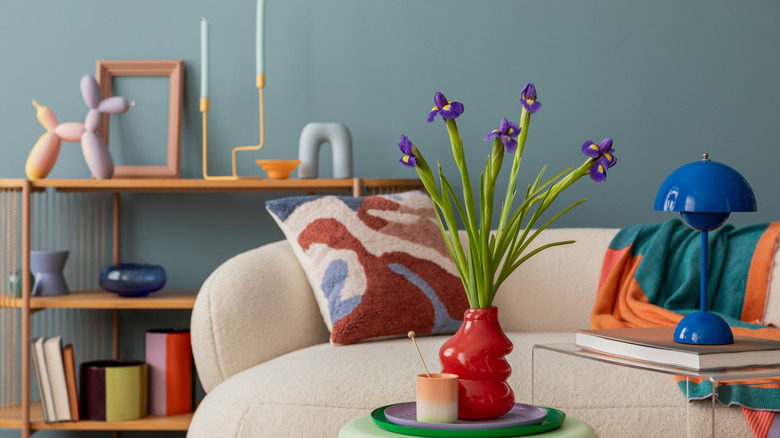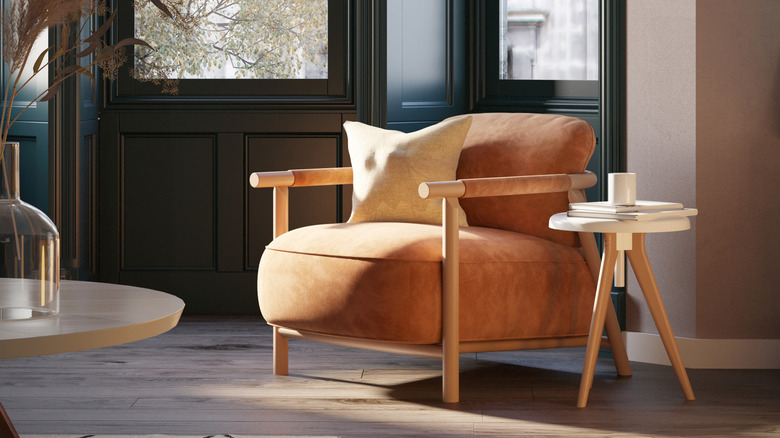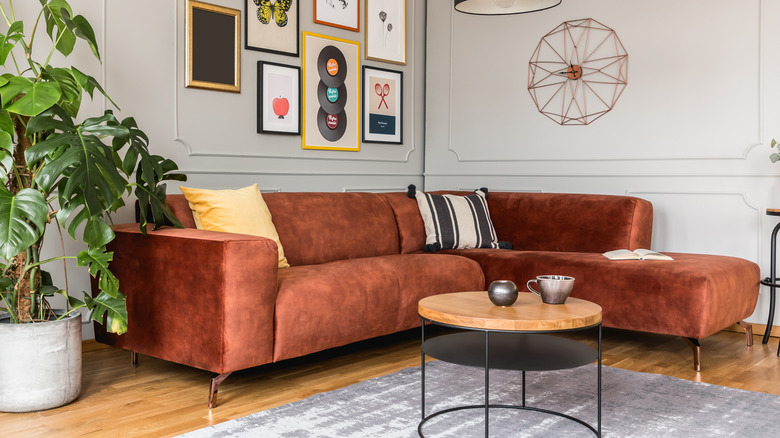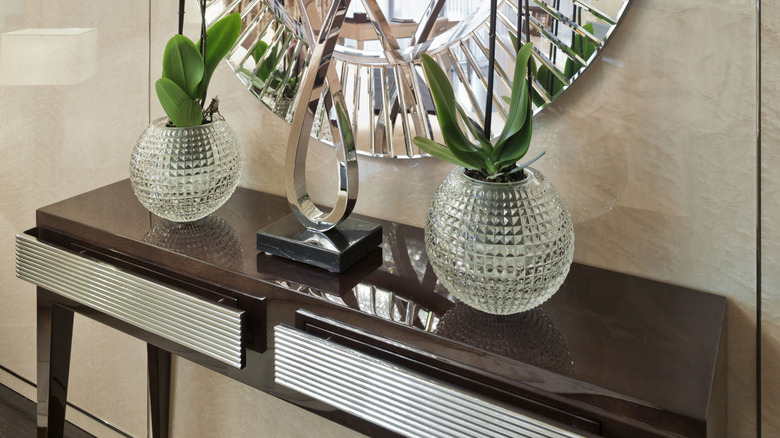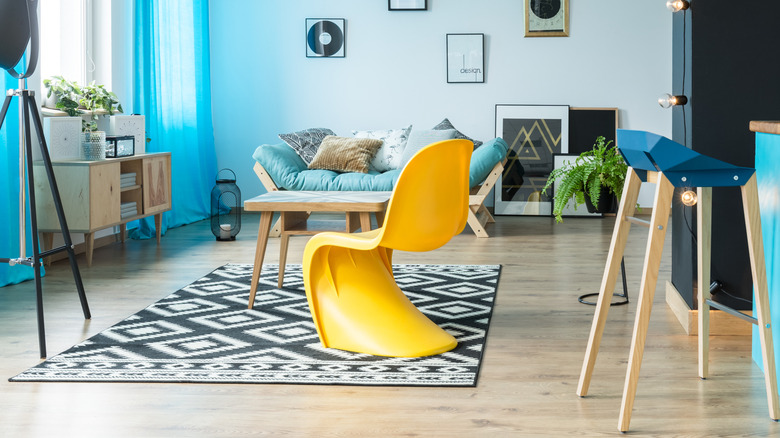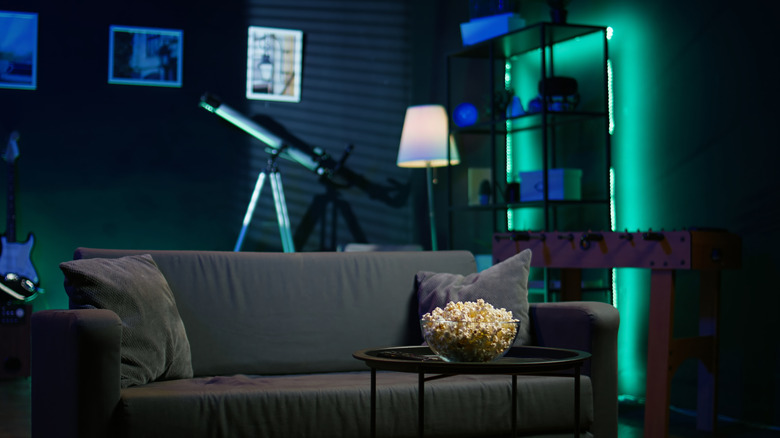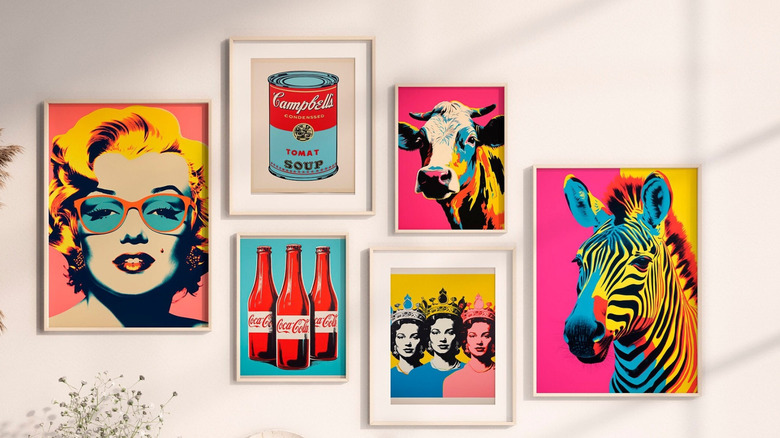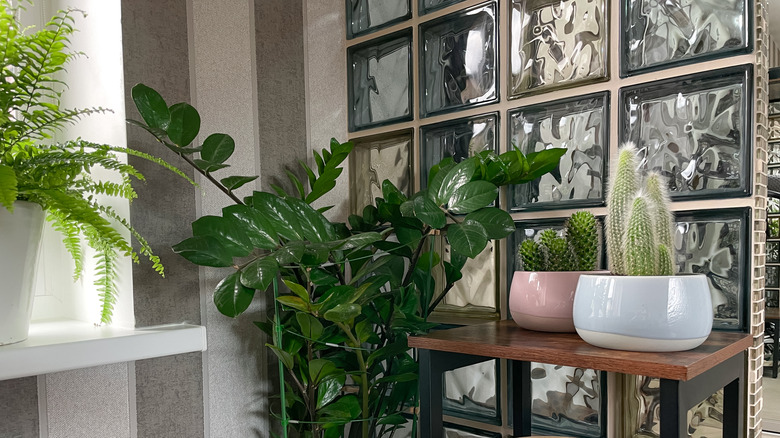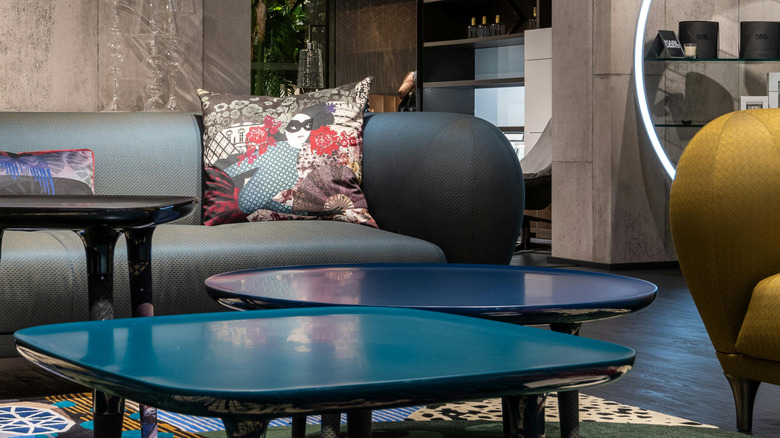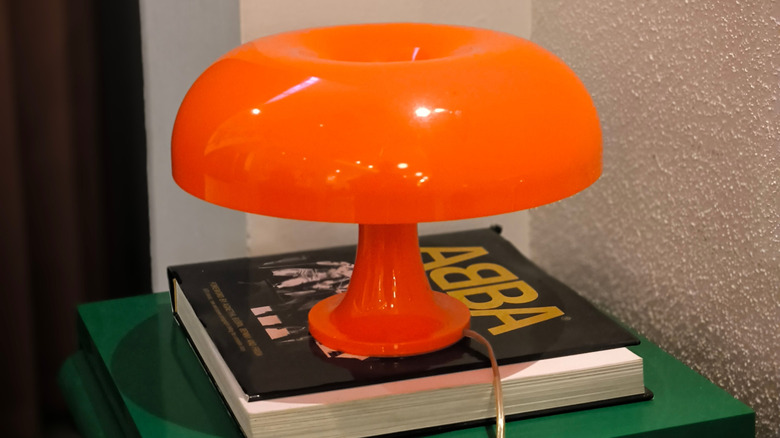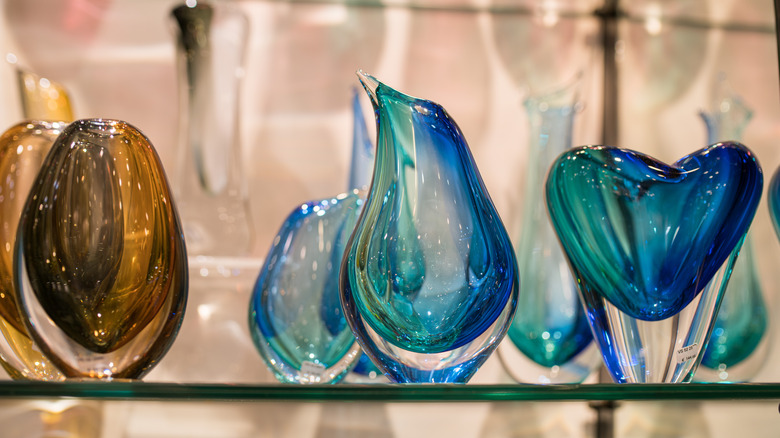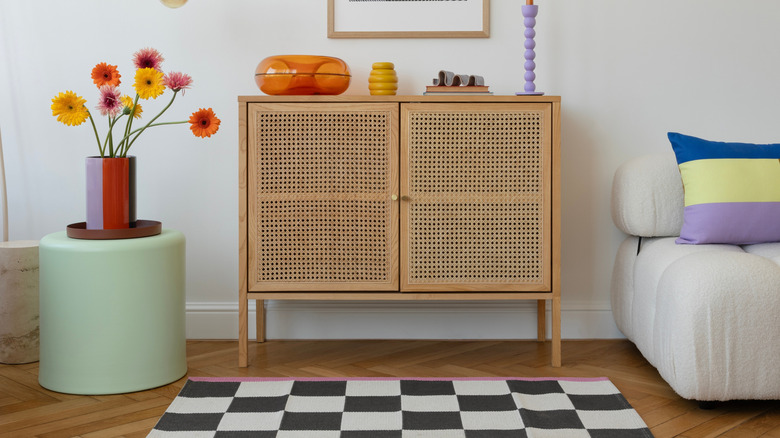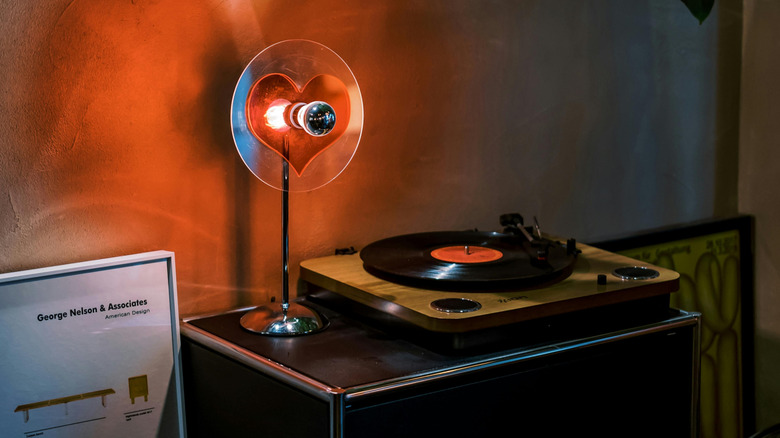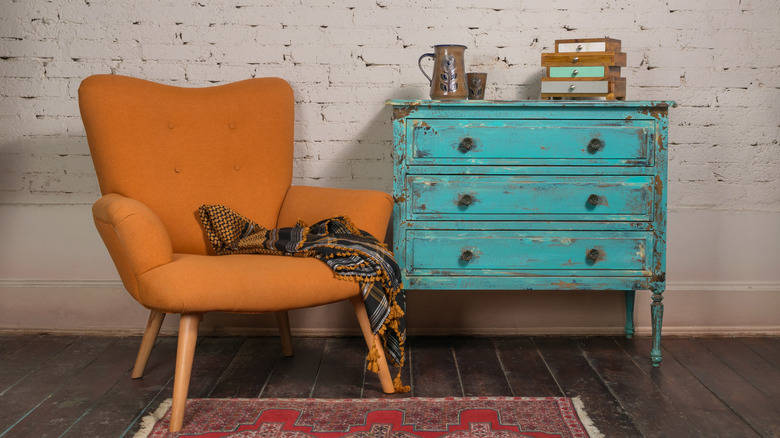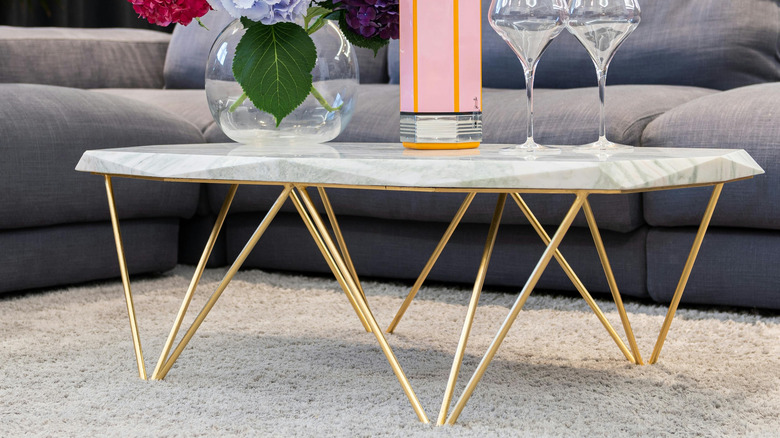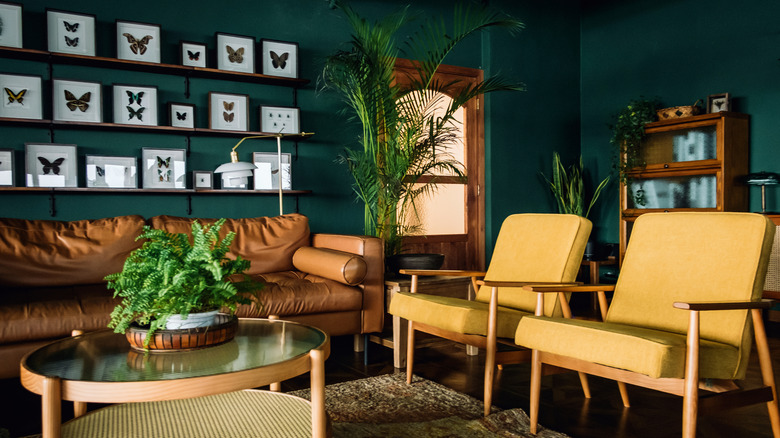16 Ways To Bring The '80s Retro Aesthetic Into Your Living Room
We may receive a commission on purchases made from links.
The 1980s were bold, vibrant, and very unique when it came to interior design. The decade leaned into excess and bold self-expression. What's interesting is that the '80s aesthetic is making a strong comeback, largely fueled by nostalgia. Pop culture, especially TV shows like Stranger Things, has reintroduced the era to the current generation. Some of the design elements popular in this decade include cozy furniture, sculptural lighting, and more that can still make a statement in a living area today. But, what makes a "retro" or "vintage" interior design scheme scream "'80s"?
If you're considering bringing this vibe into your living room, it's about more than just grabbing old pieces from a thrift store. The key lies in identifying and balancing the signature elements of the decade: Bold patterns, glossy finishes, geometric furniture, pastel palettes, and high-tech influences. In the next slides, we'll break down these defining features and show you practical ways to bring the daring '80s trends taking over home design into your home.
Bold and pastel colors instantly channel the '80s aesthetic
One of the most defining aspects of 1980s interior design was its bold embrace of color. Designers leaned heavily into both extremes, such as vivid brights and delicate pastels. Neon pink and electric blue became cultural icons, often paired with softer tones like peach, mauve, and seafoam green. The result was an aesthetic that stood out from the muted earth tones of the '70s.
To bring this look into your living room today, start with bright pastel walls, and layer in pops of bold shades through accessories like neon throw pillows, artwork, or bold furniture. Mauve, particularly, is the trendy '80s color that's making a hard comeback in this current time. Incorporate bold patterns into your living room with wallpapers and upholstery. Statement furniture pieces are excellent nods to the era. For example, an authentic vintage piece like this Cannaregios sofa in a saturated, colorblocked fabric can become the perfect centerpiece, tying your '80s-inspired palette together.
Large, sink-into-me furnishings create that plush '80s vibe
In the 1980s, bigger often meant better, especially when it came to living room furniture. Oversized furniture became the centerpiece of interiors, made with plush materials that give off a comforting and warm feel. This plush aesthetic involved shaggy rugs underfoot, layering softness and texture into every corner. Together, these elements created living rooms that felt indulgent, dramatic, and unmistakably inviting.
To channel that cozy '80s vibe today, consider investing in a large sofa or a generously cushioned boucle lounge chair that encourages you to sink in comfort and stay a while. Incorporate plush bean bags to amplify the sense of coziness. A statement piece like the Imada sofa by Lulu and Georgia or the oversized boucle couch by VANOMi captures this plush spirit beautifully, offering both scale and comfort while fitting seamlessly into contemporary interiors. This blend of tactile materials and oversized proportions is what gives an '80s-style living room its signature warmth.
Curved and sectional sofas define the decade's playful layouts
The 1980s leaned into bold experimentation with shapes. Traditional straight-lined couches gave way to modular sectionals in rich fabrics and curved sofas in bright colors that embodied the decade's spirit. Rounded furniture in particular became the icon of '80s design, often upholstered in daring colors like neon green or hot pink. The effect was sculptural yet inviting, proving that furniture could be both art and function.
To bring this aesthetic into your living room today, opt for a curved sofa upholstered in a bold color or choose a modular sectional you can rearrange for flexible layouts. Arrange seating around a low glass or brass table as a centerpiece to enhance the retro vibe. Don't be afraid of making a deep-seated sofa the star of your space. In the '80s, it was often the most popular piece in the room. This curvy green sofa, for instance, channels the decade perfectly, while still feeling fresh when balanced with neutral walls and modern accents.
Glossy glass and chrome accessories and furniture add futuristic glam
One of the defining hallmarks of 1980s design was its love affair with shiny, reflective surfaces. Mirrored furniture, lacquered finishes, glass tabletops, and chrome accents created interiors that felt glamorous and full of energy. Chrome and glass embodied the sleek, futuristic optimism of the decade, often paired with bold colors and warm textures to balance their cool edge. This interplay of reflective and soft surfaces was central to the '80s aesthetic.
Glossy finishes are a popular '80s design trend that is back in style with a modern twist. Think chrome coffee tables. Smaller accessories, like glass vases or mirrored trays, can also provide the shimmer without overwhelming a space. Pair these reflective surfaces with plush or textured furniture to create the kind of contrast that makes the look feel authentic. A statement item, like one of these geometric ceramic flower pots can act as both a functional piece and a focal point, instantly giving your space that futuristic, retro glam feel.
Geometric patterns bring energy and bold visual impact
In the '80s, interior design loosened its tie and had some fun. Geometric patterns were a hallmark of the Memphis Design Group of Milan, Italy in the '80s. They popularized an explosion of shapes like zig-zags, squiggles, triangles, and bold checkerboards, all arranged asymmetrically. To top it off, these shapes came dressed in the decade's most known colors of neons, blues, reds, and vibrant yellows, often clashing with black and white graphics.
The secret to bringing this look back without feeling like you're trapped in a vintage mall is restraint. Start small and bold with a geometric area rug that anchors the room, or try a few throw pillows in an abstract Memphis-inspired print. If you're feeling artsy, swap your landscape art for a graphic, abstract print on the wall that uses those Memphis shapes. One piece of decor you can use to achieve this is a Geometric Design Shard Wool Rug. This keeps the look curated, not costumed.
Neon lights and signs make your living room pop
Nothing screams '80s like the electric glow of neon. The neon obsession was heavily influenced by TV shows like Miami Vice, which splashed vivid, electric colors like neon pink and electric cyan across every scene. Neon signs became popular and made buildings and signposts trendy. Whether used for advertisements or design, neon was the ultimate way to make an unapologetically bold statement about individuality.
Today, you can get that iconic glow without the high cost and fragile glass. There is an option of LED neon, which is safer and more durable than traditional glass neon. Neon signs are perfect as a focal point, so try a custom-made neon phrase sign or DIY a geometric shape with bendable LED ropes above a sofa or in an entertainment corner. If you're going for maximum impact, choose a bright color that contrasts with your wall, and pair it with a mirrored surface nearby to double that fabulous neon effect.
Gallery walls with eclectic art showcase '80s creativity
The place where the '80s ditched most of the prevailing design rules was on the walls. This decade saw a major embrace of Neo-Expressionism and Neo-Pop Art. The best way to show off this no-rules attitude was the eclectic gallery wall. It was the perfect maximalist home for loud colors, graphic shapes, and the glorious notion that everything you love belongs on the wall.
Creating a modern, '80s-inspired gallery wall is more about confident clashing. Start by finding your anchor piece, maybe a large, abstract canvas with strong geometric shapes or a pop-art print. Then, surround it with a wild mix of maps, small mirrors, and family photos. The real trick is the frame game. Mix different styles, colors, and textures. Consider both metal frames and chunky wood. And here's a room tip for that authentic look: Hit up craft fairs and thrift stores for unique, quirky pieces like this eclectic abstract painting, because the more unique they are, the more '80s your wall looks.
Glass block walls bring architectural flair from the '80s
Before the 1980s, people had begun to lose interest in glass blocks until they gained popularity again in that decade. Offering the ideal combination of natural light diffusion and complete privacy, they were a staple in suburban homes. This gridded, translucent aesthetic was a welcome change from solid, opaque walls, which limited the natural light that could be spread through a house.
To bring glass blocks into your modern home without looking cluttered, use them with a less-is-more mindset. They are perfect for a custom bar or as a partial room divider in an open-plan space, segmenting areas without sacrificing light flow. For a truly contemporary update, ditch the typical wavy pattern for a cleaner, matte pattern. A simple, sleek row of glass blocks can also make a fantastic living room window that can come in any design you can think of, or will be a suitable base for a side table with wooden features.
Layered textures make the space rich and retro
This era was about opulence and excess. This maximalist attitude manifested as the fearless pairing of high-contrast textures, clashing colors, and bold patterns. The combination of gleaming chrome, smooth brass, and heavily veined marble with floral textiles was designed to create drama, depth, and a sense of unapologetic indulgence in every corner of the room.
To master the modern '80s texture mix, focus on intentional contrast. One way to do this is with statement pieces such as a velvet sofa and a richly grained wooden table. The contrast gives your '80s decor more depth. Using different patterns is a perfect way to build or layer texture in a modern setting. Add a chrome-legged coffee table or a glass side table, as these reflective materials were '80s favorites. You can layer the rugs in your living room as a great way to let the textures speak, too. This balancing act ensures the space feels rich and harmonized, not cluttered.
Sculptural light fixtures double as functional art
In the 1980s, lighting fixtures transcended mere utility to become bold and expressive forms of decor. Driven by the Memphis Design group and Postmodernism, which rejected minimalism, fixtures embraced playful, geometric, and often chaotic shapes. Fixtures, particularly the era's desk lamps, looked like abstract sculptures or futuristic gadgets, often combining high-tech materials like glass and aluminum. The goal was not just illumination, but to make a loud, confident, and unapologetically stylish statement.
To incorporate this trend with modern restraint, select one dominant fixture to serve as a focal point. Look for oversized shapes that defy the norm, a mushroom table lamp with its soft, curved silhouette. This can serve as an eye-catching centerpiece. Or, focus on materials like matte plaster for a refined take on the '80s fondness for textural contrast. For an edgy look, try this alabaster pendant lamp to instantly add that touch of confident '80s-inspired architectural drama.
Funky knickknacks keep the playful energy alive
The 1980s infused vibrancy in home design, and displaying funky knickknacks is one of the easiest ways to do this. Quirky decorative pieces, like unusually shaped vases and clocks, reflected the era's love of whimsy. The influential Memphis Design Group especially encouraged unusual shapes and bold colors in everyday objects. Think of curvilinear Murano glass vases or funky-shaped acrylic bookends. These touches made interiors feel vibrant, fun, and far from ordinary.
To channel this energy today, look for retro-style ceramics in abstract shapes, or funky vases to use as table centerpieces. Check out the myriad glass forms of the Venetian glass firm Murano, or acrylic vases and vessels inspired by the designer Shiro Kuramata. The key is to sprinkle them throughout your living room, on coffee tables, shelves, or consoles, so they stand out without overwhelming the space.
Rattan and wicker decorations soften the high-gloss '80s look
'80s interiors were often dominated by the sleek, cool aesthetics of chrome, glass, and highly lacquered surfaces. Amidst this glamor, rattan and wicker served a vital role, offering a necessary addition to the versatile textures associated with the '80s. This period of fondness for naturalistic materials, sometimes referred to as the "Golden Girls Era", saw the increased use of rattan. Rattan material was easier to make furniture with and was known to be durable and more affordable in comparison to wood or bamboo.
Following the '80s decor trend, you can incorporate rattan into every room in your home – especially the living room. To keep the look sophisticated in smaller rooms, use rattan sparingly as a bold accent rather than a whole set. Introduce a rattan coffee table or side table; this goes well with pastel sofas. You can place a medium-sized wicker basket on the center table for storage. The key is to mix the textures, pair your woven piece directly next to a glossy or mirrored surface, or a polished metal fixture.
Entertainment corners celebrate '80s technology and culture
The 1980s were a pivotal time for home technology, making the living room a vibrant hub for music and gaming. The era celebrated consumer electronics as much for their status as for their function. Televisions, bulky VCRs, and stereo systems transformed furniture into dedicated media storage units.
To celebrate this technological spirit today, create a nostalgic corner that blends old-school charm with modern functionality. Having an entertainment corner is one of the top ways to incorporate vintage decor into your maximalist home. Anchor the area with a retro-style record player or a vintage television set. Pair these with an '80s gaming console or an analog clock radio for the full vintage effect. Display these pieces on a sleek black or chrome stand. Throw in an old school boom-box for that full '80s feel. A Crosley Arcata Player Stand acts as both functional, ready-to-use entertainment and a conversational piece of decor, a perfect, playful tribute to the golden age of gadgets.
Patinated accessories bring character and vintage charm
Not everything in this era was a glossy explosion of perfect shapes and edgy materials. To ground the era's bold, graphic interiors, filled with glass, chrome, and pastel neon, designers strategically incorporated natural wood furniture and patinated finishes. This rich, heavy texture of aged cabinetry and hardwood furnishings found in homes added depth and a sophisticated feel. These heavier, antique-inspired pieces offered a calming visual anchor against the decade's excess and high-contrast styles.
To achieve this sophisticated effect in your home's decor, choose large vintage or mid-century pieces like antique sideboards or classic wood drawer chests. Use these heavy, dark items to directly combine with the sleeker '80s elements. Place a glass coffee table on top of an antique rug, or position a vintage wooden cabinet, like this weathered wood-look cabinet, directly against a pastel wall. This purposeful tension between Old World weight and modern shine is key to a balanced '80s revival.
Metallic table legs highlight the decade's love for glam
The 1980s were an era defined by bold excess and a visible love for luxury, best exemplified by the ubiquitous presence of metallic accents. Accessories, furniture, and fixtures were often mounted upon legs or stands in gleaming gold, chrome, and brass finishes to create a look of instant opulence. Inspired by the revival of Art Deco glamor and these accents reflected light and high-shine surfaces meant to give off the impression of wealth.
To incorporate this trend, you can buy ready-made furniture pieces like this drinks stand with chome base. Or, you can add your own metallic legs to existing pieces of furniture. Many sofas, tables, and chairs have interchangeable legs which can easily be unscrewed and swapped out with the legs of your choice, such as these geometric brass table legs.
Tropical houseplants add vibrancy and life to retro interiors
The maximalist '80s saw a lot of homeowners obsessed with oversized everything, a vibe that was channeled directly into the home via giant houseplants. Large, leafy plants like kentia palms, or monstera, were staples, serving as living sculptures that softened the hard lines of geometric furniture and high-gloss surfaces. These plants created a bright, decorative aesthetic, blending the era's taste for bold color and bright sunlight with the warm, exotic feel of a permanent vacation.
To master this look, don't be afraid to go big. Pick the perfect plant for your style by placing a single large potted Monstera in a corner to serve as an eye-catching architectural feature. The key is the container. Pair your leafy statement plant with woven planters or a vibrant ceramic pot to complete the retro vibe. The inclusion of this organic element provides the perfect final organic contrast, ensuring your throwback interiors feel vibrant, alive, and thoroughly modern.
